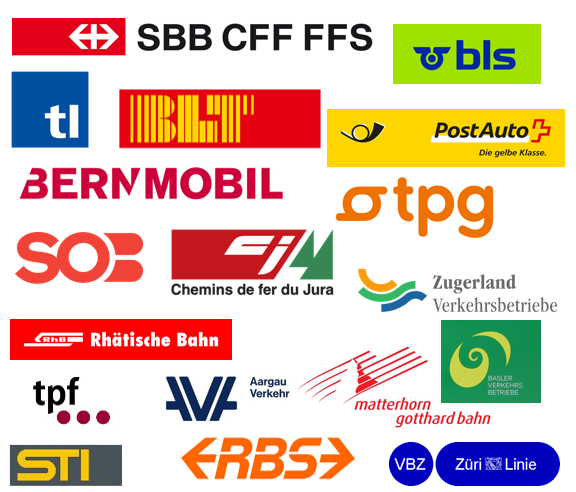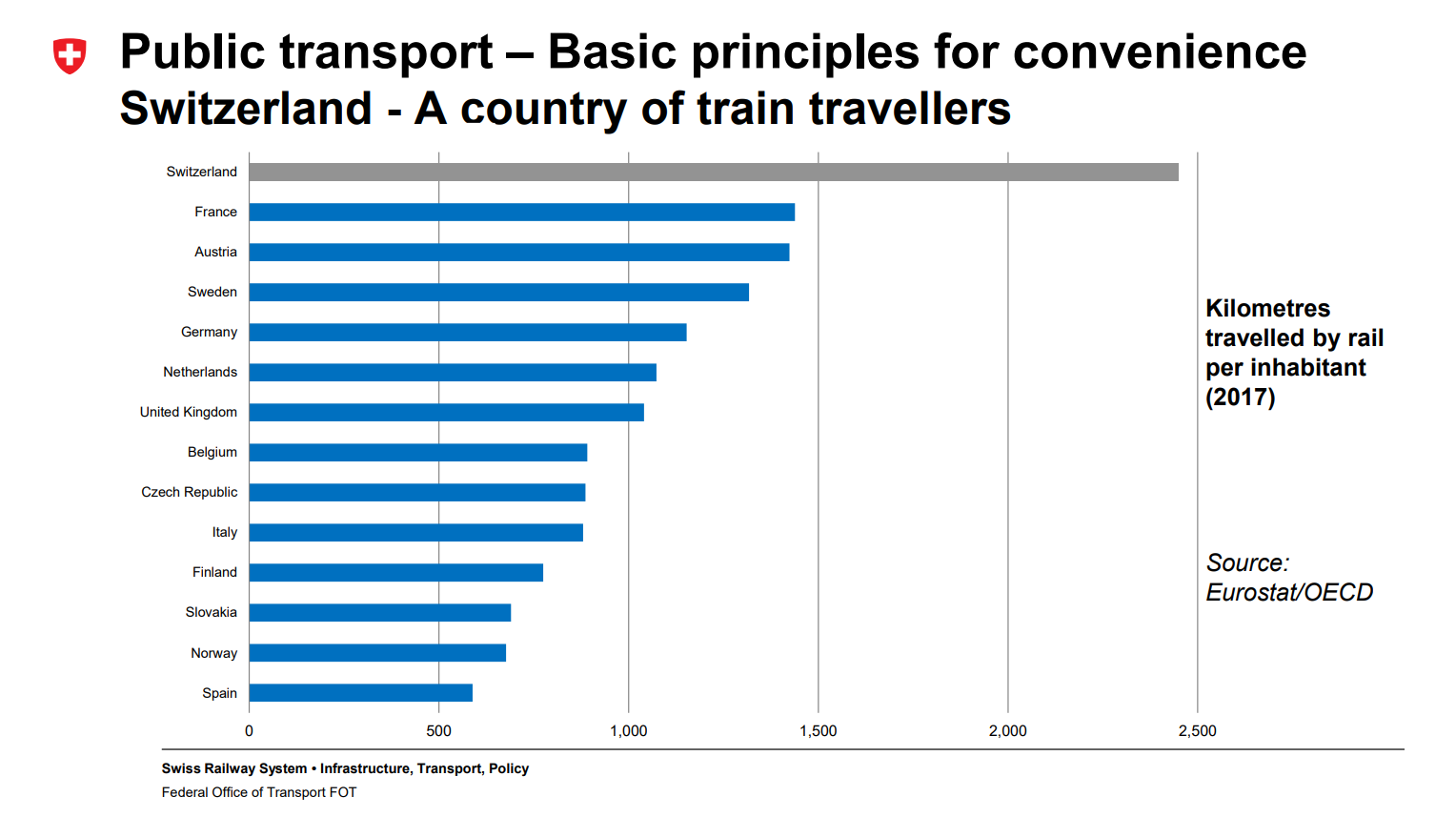“One journey, one ticket”: Summary of Day 1 of the SwissCal Conference
Slide from the presentation from Alliance Swisspass, the special-purpose authority that oversees the integrated national fare pass.
This blog post is the first in a three-part series that will discuss key learnings from each session of the SwissCal Virtual Conference on the Swiss Public Transportation Ecosystem, a virtual conference co-hosted by LA Metro, Southern California Association of Governments, Stanford University’s Bill Lane Center for the American West, and Caltrans.
A detailed summary of the first session is included in this post - however, the following were the main takeaways:
Switzerland has one of the highest ridership transit networks in the world, despite being a country with four language regions, a complex geography, and several different transit operators.
Coordination is viewed as key to its success, which is done at both a federal and regional level.
A critical factor in its successful coordination is the federal government setting goals and standards for the system as a whole.
An organized industry association plays a central role, collaborating across multiple operators to develop unified plans on how to meet the federal goals and standards. An example of this is the federal requirement of providing “direct service”, or unified fares, requiring transit operators to maintain and regularly update a unified fare structure.
The federal government also sometimes designates a specific transit operator to lead coordination among transit companies, such as in the areas of customer information and setting real time data standards.
--
Word Cloud conducted among conference attendees shows that attendees came from all across California, with Los Angeles especially well represented.
Tuesday, February 1st, 2022 marked the first day of the SwissCal Conference. Seamless Bay Area and its co-hosting partners kicked off the event with opening remarks from representatives of SCAG, Caltrans, LA Metro, and MTC. Over ninety people attended the first session, joining from different regions within California, with others attending from outside the state and even outside the country.
This session set the context for the entire conference. Anna Barbara Remund of the Swiss Federal Office of Transport (FOT) and Kathrin Räss of Alliance SwissPass presented. Remund gave an overview of the Swiss transport ecosystem, defined the role the federal government plays, and provided an overview of the regulatory landscape. Räss presented on the role of agreements between operators and tariff communities.
Switzerland: Demographics and Landscape
Remund began by providing a comparison between Switzerland and the Bay Area. Switzerland is a small country with a population of 8.6 million people. It is slightly more populous than the San Francisco Bay Area and double the area in terms of size. Only about 8% of Switzerland represents settled areas, so a strong public transportation system serves as a vital connection between different regions and destinations.
The Three Levels of Actors in the Swiss Public Transport System
Despite the country’s size, Switzerland has a total of 460 transportation companies, which includes 80 railway companies. There are different actors at each level who play a key role in ensuring seamlessness in the Swiss transport system. Swiss transport policy is based on the development of an eco-friendly and socially sound transport system which is efficiently organized and embedded within the larger European context.
Remund then explained the three different levels of public transit actors in Switzerland and how they generally interact.
Some of the public transport operators in Switzerland and their logos.
Governmental Level:
The federal government, or the Federal Office of Transport (FOT), is one of seven divisions in the Swiss Federal Department of Environment, Transport, Energy and Communications. They oversee strategic planning and fully finance railway infrastructure, are the safety authority for the entire public transport sector, and define the legal framework for public transport in Switzerland.
The cantonal actors (roughly analogous to “counties” in the US) and municipalities, are the other actors at the governmental level. They are in charge of financing regional and local transport services.
Semi-Public Level:
At the semi-public level are companies that are entirely or partially owned by the state, including Swiss National Railways (SBB), the Association of Swiss Transport Operators (VOV-UTP), and Alliance SwissPass. They operate a majority of the transit and oversee some aspects of coordination when such authority is delegated to them by FOT. The FOT sets targets for them for a period of four years at a time, and these targets are reviewed on a regular basis. The semi-public companies and associations are free to implement these targets in any way they see fit.
Private Level:
While Remund characterized the lowest tier of this ecosystem as the “private” level, in reality this tier consists mostly of publicly-owned and governed public transit operators.
Most transit operators are arms-length companies fully owned by public jurisdictions. An example is Transport Public Genevois (TPG), the main operator of transit in the Geneva region, which is a company owned fully by the canton of Geneva. However, fully private (and not publicly-owned) companies are also included in this level, such as Swiss startup FAIRTIQ, which contracts with public operators to provide mobile ticketing for a number of operators in Switzerland.
Popularity of Swiss Public Transport
Switzerland has the most densely-used railway network in the world, comparable only to Japan. The average person travels seventy times a year by train, amassing a distance of 1,500 miles a year; transport is so widely valued that it represents a significant cost share in the federal budget (nearly 15%, two-thirds of which is allocated to public transport).
Ensuring Seamlessness: Direct Service (One Journey, One Ticket) and “One for All” System
Remund explained how Swiss public transport’s structured timetable shortens connections and travel times for users. Public transport is treated as one system regardless of the connection a rider is using (bus, tram, rail, etc.). Switzerland utilizes the concept of the node principle and a structured timetable for its transit scheduling. This means that long distance trains leave right after the hour and reach the next big station right before the hour. At the corresponding connection, a rider can change to another long distance train, leaving again, just after the hour. They can also catch a regional train or bus as their timetables are coordinated with the time tables of the long distance trains.
The map to the left demonstrates an example of how the node principle is employed, identifying key hubs in the Swiss transport network. The clock to the right shows how the timetables are coordinated so that one connection arrives before the hour, and the other leaves right after the hour.
There is one ticket for the entire system, which is referred to as “direct service.” In her presentation, Kathrin Räss of Alliance SwissPass, the national public transport fare organization that is made up of all transport operators and fare associations in the country, clarified that this is a legal obligation for all public transport providers and requires close cooperation between public transport providers. Through this direct service system, customers are able to buy simple and universal multi-modal, one-way trip tickets as well as travel cards and travel passes that are valid for multiple forms of transportation. This enables the user to have choices while using the system. They can choose any train or operator and just need to arrive the same day. All 250 operators and 18 fare network associations sell the tickets. Longer distances are discounted.
An innovative practice that several conference participants took interest in was Switzerland’s practice of “system leadership.” For certain transit system functions, such as customer information, FOT will designate one public transit service provider responsible for setting standards and overseeing coordination for the entire sector for a certain domain or task. It is fully financed by the confederation (FOT). The goals are to ensure user-friendliness, efficiency, quality, and interoperability. For example, SBB is in charge of making timetables and real-time information accessible. They also host an open data platform.
One could imagine applying this concept to the Bay Area; for example, a network manager could designate BART to be the “system leader” for timetable development for the region; and could designate SFMTA to be the “system” leader for wayfinding and customer information.
Fare Collection and Fare Distribution Across Operators
Half of the cost of transit in Switzerland is covered by the user, and the other half is covered by subsidies from the confederation, cantons, and municipalities. Alliance SwissPass, the transport companies, and fare network associations work on products that include all-inclusive travel cards and passes, as well as common rules and standards for tickets. This is crucial to securing income. The NOVA platform, used for ticketing across operators, is a common database on the sales backend.
Fare revenue distribution for tickets that use only one transit agency is straightforward. To distribute income from travel passes such as one-day tickets, where riders may use multiple agencies, Alliance SwissPass conducts regular surveys of usage. Respondents are asked to fill out a questionnaire on their public transportation usage patterns over a given week. Alliance SwissPass is working to improve and test more accurate ways of assessing usage via sensors in vehicles.
--
Want to watch the presentation in full? A recording of the entire session can be seen here.








